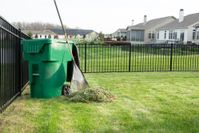
People tend to think of spring and summer as times to focus on lawn care and landscaping. However, with a little effort in the fall, you can help your grass grow thick and green when warm temperatures return in the spring. Here are some tips for prepping your lawn for winter to get you started on taking advantage of the season.
How to Transition to Winter Lawn Care
1. Leave Your Clippings
 Turf experts from the University of Connecticut told the Hartford Courant that local residents should use their lawn clippings as fertilizer. By adding this natural element to your grass, you’ll reduce the need for extra nitrogen by up to 50 percent, saving money on fertilizer and minimizing your lawn care efforts.
Turf experts from the University of Connecticut told the Hartford Courant that local residents should use their lawn clippings as fertilizer. By adding this natural element to your grass, you’ll reduce the need for extra nitrogen by up to 50 percent, saving money on fertilizer and minimizing your lawn care efforts.
2. Apply New Seed
Fall offers the perfect time to touch up your grass by adding new seed. Use a blend of cool weather grasses like perennial ryegrass, Kentucky bluegrass, and fine fescue for the most durable, lush grass. Apply the seed in the early fall, and water frequently to ensure the grasses take root.
3. Fertilize Cool-Weather Grasses
Cool-weather grass varieties grow the most in the fall, so this is the season to fertilize. Apply a nutrient mixture of phosphorous, nitrogen, and potassium in the fall to facilitate healthy grass. Then, follow up that application in a month to increase durability and height. With ample waterings, they’ll shoot up and require extra lawn care like more frequent mowing. Around December, the grasses will likely die off because of the cold, and you can retire your fertilizer until next year.
Homeowners interested in learning more area lawn care tips should contact the professionals at The Lawn Surgeon in Middlesex and Greater Hartford Counties, CT. The company has been in business since 1985 providing landscape management services for residences and businesses. Call (860) 635-1127 or visit the website for information on their lawn mowing, mulching, seeding, and pest control offerings and to sign up for snow removal so you’re ready when winter hits.
About the Business
Have a question? Ask the experts!
Send your question

